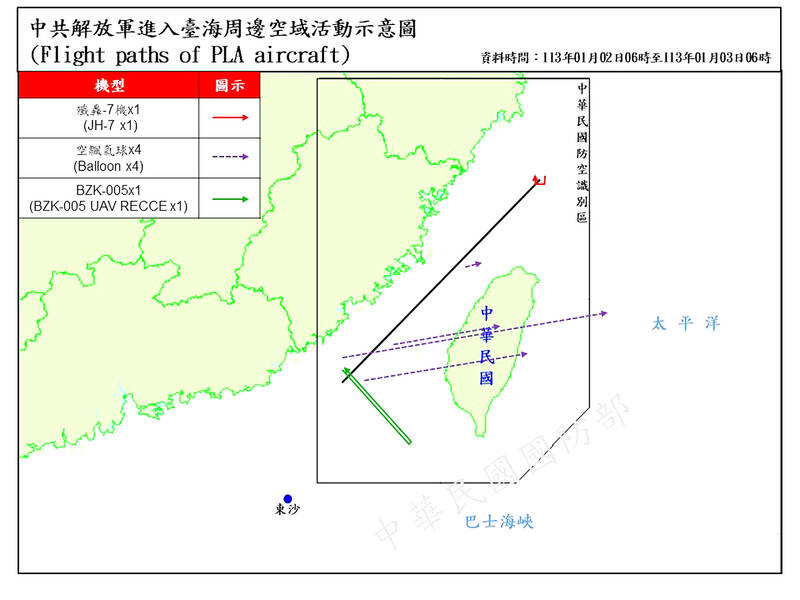Four Chinese balloons on Tuesday drifted across the Taiwan Strait, with three of them crossing over Taiwan proper, the Ministry of National Defense said yesterday, following two more sightings the day before.
Tuesday’s balloons all drifted northeast and disappeared at 10:48am, 5:18pm, 7:01pm and 7:02pm, the ministry said.
They were floating at altitudes of 3,658m, 5,486m, 6,706m and 7,315m respectively, it said, adding that it was the ninth time Chinese balloons had been detected since last month.

Photo courtesy of the Ministry of National Defense
On Monday, two balloons were sighted, one of which crossed over Taiwan proper.
Ministry spokesman Sun Li-fang (孫立方) did not say whether the military believed the latest balloons were for weather or espionage purposes, but the ministry has previously said that most Chinese balloons flying in the area were weather balloons.
The military closely monitors the balloons’ movements and informs civil aviation authorities, Sun said.
“The nation’s armed forces respond appropriately to unidentified balloons found entering Taiwan’s airspace based on the level of threat they pose to national security,” he said, without elaborating.
The ministry last year said that similar devices had been regularly detected around Taiwan, most often between the months of December and February, as seasonal winds bring the balloons closer to Taiwan.
The military does not believe the balloons are directly related to Taiwan’s presidential and legislative elections, to be held on Saturday next week, Sun told a ministry news briefing on Tuesday last week.
Ou Si-fu (歐錫富), a research fellow at the Institute for National Defense and Security Research, said that the balloons are “for military coercion and psychological warfare.”
“The presidential election is coming and balloons are a kind of military intimidating tool,” he said, adding that China wants more “pro-Beijing votes.”
In the 24 hours ending at 6am yesterday, the ministry also detected nine Chinese People’s Liberation Army aircraft and four navy vessels operating near Taiwan.
Two of the aircraft — a Xian JH-7 bomber and a Harbin BZK-005 reconnaissance drone — crossed the median line of the Taiwan Strait into the nation’s north and southwest air defense identification zone, the ministry said.
Beijing has in the past few years ramped up military and political pressure on the government of President Tsai Ing-wen (蔡英文), and also refused to engage with her during her tenure.
It has sent an unprecedented number of warplanes and naval vessels around Taiwan, dubbed by military experts as “gray zone” tactics designed to intimidate Taiwanese.

Taiwan Semiconductor Manufacturing Co (TSMC, 台積電) is expected to start construction of its 1.4-nanometer chip manufacturing facilities at the Central Taiwan Science Park (CTSP, 中部科學園區) as early as October, the Chinese-language Liberty Times (the Taipei Times’ sister newspaper) reported yesterday, citing the park administration. TSMC acquired land for the second phase of the park’s expansion in Taichung in June. Large cement, construction and facility engineering companies in central Taiwan have reportedly been receiving bids for TSMC-related projects, the report said. Supply-chain firms estimated that the business opportunities for engineering, equipment and materials supply, and back-end packaging and testing could reach as high as

CHAMPIONS: President Lai congratulated the players’ outstanding performance, cheering them for marking a new milestone in the nation’s baseball history Taiwan on Sunday won their first Little League Baseball World Series (LLBWS) title in 29 years, as Taipei’s Dong Yuan Elementary School defeated a team from Las Vegas 7-0 in the championship game in South Williamsport, Pennsylvania. It was Taiwan’s first championship in the annual tournament since 1996, ending a nearly three-decade drought. “It has been a very long time ... and we finally made it,” Taiwan manager Lai Min-nan (賴敏男) said after the game. Lai said he last managed a Dong Yuan team in at the South Williamsport in 2015, when they were eliminated after four games. “There is

POWER PLANT POLL: The TPP said the number of ‘yes’ votes showed that the energy policy should be corrected, and the KMT said the result was a win for the people’s voice The government does not rule out advanced nuclear energy generation if it meets the government’s three prerequisites, President William Lai (賴清德) said last night after the number of votes in favor of restarting a nuclear power plant outnumbered the “no” votes in a referendum yesterday. The referendum failed to pass, despite getting more “yes” votes, as the Referendum Act (公民投票法) states that the vote would only pass if the votes in favor account for more than one-fourth of the total number of eligible voters and outnumber the opposing votes. Yesterday’s referendum question was: “Do you agree that the Ma-anshan Nuclear Power Plant

Democratic nations should refrain from attending China’s upcoming large-scale military parade, which Beijing could use to sow discord among democracies, Mainland Affairs Council Deputy Minister Shen You-chung (沈有忠) said. China is scheduled to stage the parade on Wednesday next week to mark the 80th anniversary of Japan’s surrender in World War II. The event is expected to mobilize tens of thousands of participants and prominently showcase China’s military hardware. Speaking at a symposium in Taichung on Thursday, Shen said that Chinese Minister of Foreign Affairs Wang Yi (王毅) recently met with Indian Prime Minister Narendra Modi during a visit to New Delhi.